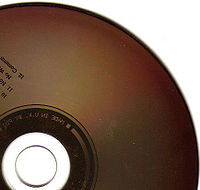Compact disc bronzing

Have you ever seen a shiny, silver or gold disc called a CD? It's used to store music or other things like pictures and documents. Well, sometimes, these shiny discs might start to turn a funny color, like bronze or brown. That's what we call compact disc bronzing.
But why does this happen? You see, the shiny part on top of the CD is called the reflective layer. This layer reflects the laser that reads the information stored on the disc, kind of like how a mirror reflects light. However, if this layer gets damaged, it can start to corrode or oxidize, which gives it that bronze or brown color. It can happen for a few different reasons like exposure to sunlight, heat or humidity over time.
The problem with bronzing is that it can make the CD difficult or impossible to read. This is because the laser can't properly reflect off the corroded layer and read the information stored on the CD. That's why it's important to store CDs in a cool and dry place, away from sunlight and any kind of moisture.
So, that's what compact disc bronzing is all about. It's just the fancy way of saying that the shiny, reflective layer on a CD gets damaged and turns a bronze or brown color, making it difficult to read.
But why does this happen? You see, the shiny part on top of the CD is called the reflective layer. This layer reflects the laser that reads the information stored on the disc, kind of like how a mirror reflects light. However, if this layer gets damaged, it can start to corrode or oxidize, which gives it that bronze or brown color. It can happen for a few different reasons like exposure to sunlight, heat or humidity over time.
The problem with bronzing is that it can make the CD difficult or impossible to read. This is because the laser can't properly reflect off the corroded layer and read the information stored on the CD. That's why it's important to store CDs in a cool and dry place, away from sunlight and any kind of moisture.
So, that's what compact disc bronzing is all about. It's just the fancy way of saying that the shiny, reflective layer on a CD gets damaged and turns a bronze or brown color, making it difficult to read.
